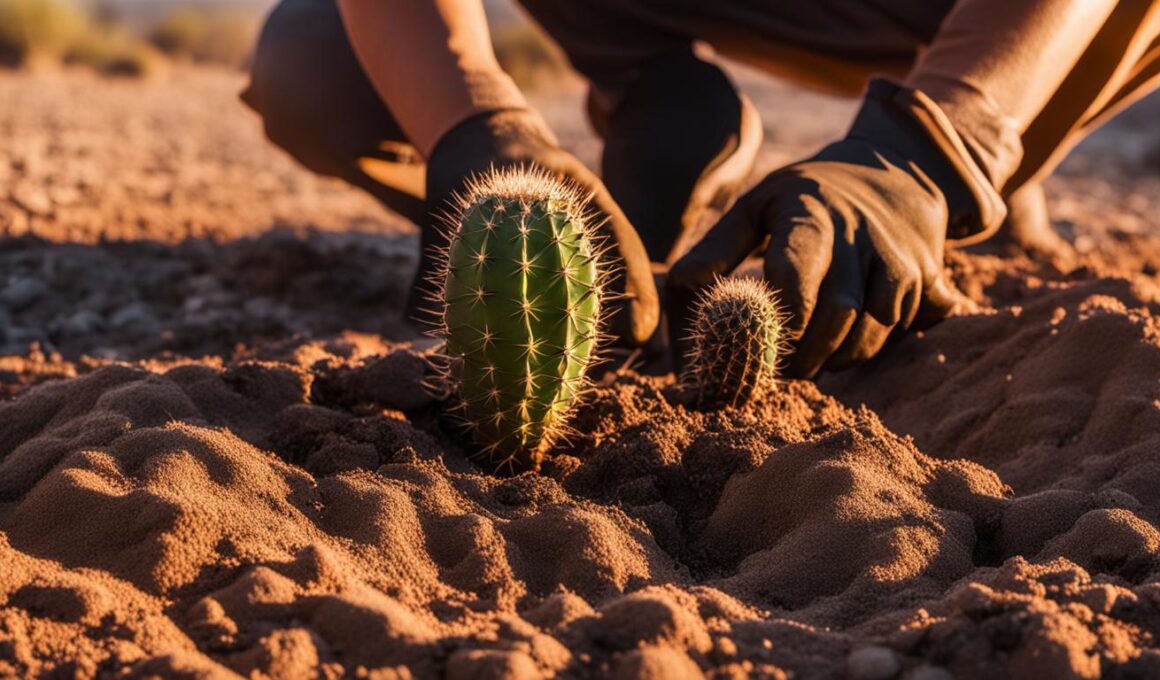Are you interested in cultivating cacti? Growing cacti from seed is a rewarding and fulfilling endeavor that allows you to witness the beauty and resilience of these drought-tolerant plants. Cacti make excellent house plants, requiring minimal care and thriving in hot and dry conditions.
Cacti come in various shapes and sizes, making them perfect for both potted arrangements and long-term indoor displays. Their fleshy, water-storing stems enable them to survive with reduced watering needs. If you’re ready to embark on your cactus-growing journey, read on to discover the essential steps and tips for success.
The first step in growing cacti from seed is to select the right varieties. There are countless options available, each with its unique charm. Some popular choices include Rebutia krainziana, Echinocactus grusonii, Gymnocalycium paraguayense, and Mammillaria spinosissima.
Next, create the ideal growing conditions for your cactus seeds. Cacti require full sun exposure, so choose a sunny spot in your home, preferably a south- or east-facing windowsill. Ensure that the compost you use is free-draining and specifically designed for cacti.
As you embark on your cactus-growing journey, it’s important to remember that these plants require minimal watering. Water them sparingly during spring and autumn, and completely stop watering during the rest of the year. This is essential to mimic their natural desert habitat and prevent overwatering, which can cause root rot.
By following these simple steps and providing the right conditions, you’ll be well on your way to successfully growing cacti from seed. Stay tuned for our next section, where we’ll explore in more detail where to plant cacti and how to plant them for optimal growth.
Where to Grow Cacti and How to Plant Them
When it comes to growing cacti, the right location and planting techniques are crucial for their survival and thriving. Here are some essential tips on where to plant your cacti and how to ensure proper growth:
Choose a Sunny Spot
Cacti are sun-loving plants and require plenty of direct sunlight to flourish. Look for a south- or east-facing windowsill that receives at least six hours of sunlight every day. This will provide your cacti with the necessary light for optimal photosynthesis and growth.
Consider Alternative Spots
If your windowsill becomes too cold during winter or doesn’t receive enough sunlight, you may need to find alternative spots for your cacti. Look for well-lit areas in your home, such as near a skylight or under artificial grow lights, to ensure your cacti continue to receive adequate light and warmth throughout the year.
Handle with Care
Before planting your cacti, it’s important to handle them with care. Cacti have spines that can prick, so always use thick tea towels or utensils like spoons and forks to avoid hurting yourself. This will help you safely position the cacti without any discomfort or injury.
Choose Free-Draining Compost
Cacti thrive in well-drained soil that allows excess water to flow through easily. Opt for cactus compost or create your own mix by combining peat-free multi-purpose compost with horticultural grit or vermiculite. This mixture promotes proper drainage and prevents waterlogged roots, a common issue that can lead to root rot.
Mulch to Protect
To prevent water from splashing back onto the cactus and causing potential damage, consider mulching the soil with horticultural grit or pebbles. This not only retains moisture in the soil but also adds an extra layer of protection against water splashing during watering.
By following these guidelines, you can ensure that your cacti thrive in their ideal environment and continue to bring beauty and uniqueness to your home. Remember, the right location and proper planting techniques are key to their successful growth.
Caring for Cactus Plants and Problem-Solving
Once you’ve successfully grown cacti from seeds and planted them, it’s essential to provide the proper care and address any potential issues that may arise. Cacti are generally low-maintenance plants, but understanding their specific needs will help them thrive in your home.
Watering Cacti
When it comes to watering your cacti, it’s crucial to strike the right balance. During the summer months, water your cacti no more than once a week. It’s better to give them a good watering less often than to provide frequent, shallow waterings. Remember, cacti are drought-tolerant plants and have adapted to survive in arid conditions.
In contrast, during the coldest months, cacti do not need any water at all. Overwatering can lead to root rot and other problems, so it’s best to err on the side of underwatering rather than overwatering.
Repotting Cacti
Every couple of years, it’s advisable to repot your cacti using fresh compost. However, it may not be necessary to move them into larger pots. Cacti prefer their roots to be slightly pot-bound, so choose a pot that is only slightly larger than their current one.
Problem-Solving for Cacti
Cacti are generally trouble-free plants, but a few common issues can arise. Overwatering and lack of sufficient light are the main culprits that can lead to problems, such as rot at the base of the cactus. To prevent this, ensure your cacti receive adequate sunlight and only water them sparingly.
If you notice spindly growth on your cacti, it’s a sign that they may not be receiving enough light. Move them to a brighter spot to promote healthier growth.
Additionally, if you have cactus seeds that you’d like to germinate, you can try the “takeaway technique.” This method involves using soil, pumice or perlite, a microwave-safe container, bottled drinking water, and a good dose of patience. Follow the instructions provided in your trusted sources to increase your chances of successful germination.
By caring for your cactus plants and promptly addressing any issues, you can ensure that they remain healthy and vibrant in your home.
Conclusion
Growing cacti from seed can be a rewarding and fulfilling experience. To successfully germinate cactus seeds, use the “takeaway technique” which has proven to be simple and effective. Start by using well-draining soil to ensure the optimal growth conditions for your cacti.
Consistent light and warmth are crucial for the successful growth of cacti. However, it is important to remember to avoid exposing them to direct sunlight, as this can damage the delicate seeds. As for watering, cacti require minimal care and should only be watered infrequently. Overwatering can lead to rotting, so it’s best to provide them with just the right amount of water.
When it comes to caring for your cacti, repotting every few years using fresh compost can help promote their growth. However, be mindful not to pot them into larger pots unnecessarily. Remember to provide proper airflow to prevent any stagnation and avoid overfeeding, as cacti are adapted to survive in nutrient-poor environments.
By following these final tips for growing cactus from seed and providing the right conditions and care, you can enjoy the beauty and resilience of cacti in your indoor space. So, go ahead and embark on this exciting journey of growing and nurturing cacti in your own home!
Can the Same Method of Growing a Lime Tree be Applied to Growing Cactus from Seed?
Yes, the same method used in a growing a lime tree tutorial can be applied to growing cactus from seed. Both plants require well-draining soil, ample sunlight, and occasional watering. However, it’s essential to research the specific needs of each plant to ensure successful growth.










